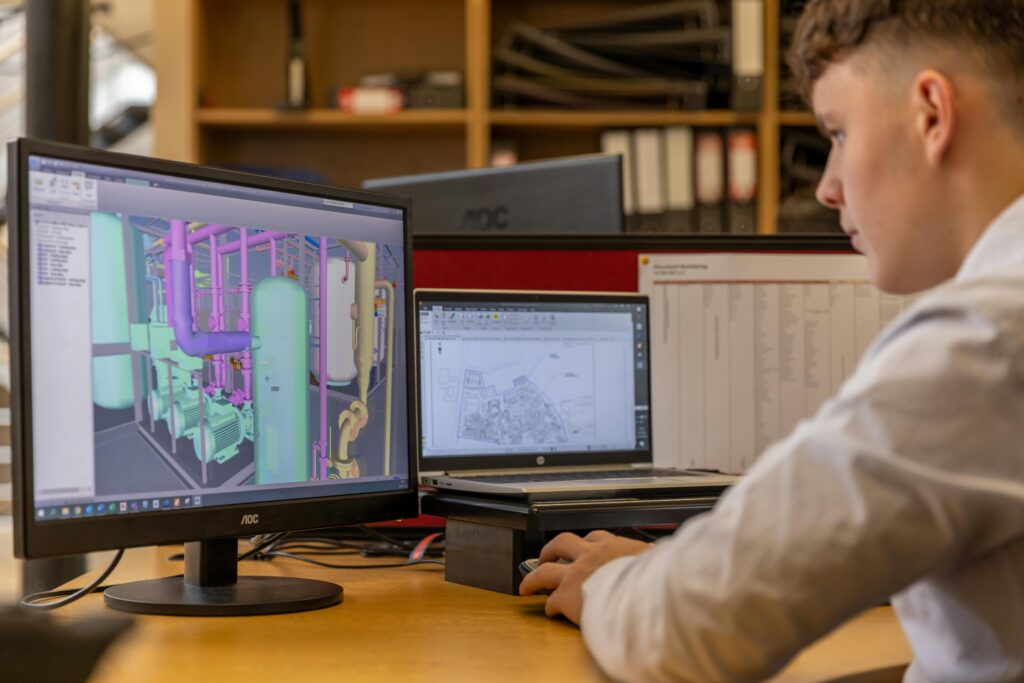Imagine walking into a modern building with perfectly functioning HVAC systems, electrical wiring, and plumbing. Ever wondered who designs these complex systems with such precision? That’s where MEP BIM Modelers come in! These professionals use BIM (Building Information Modeling) software to create detailed 3D models of Mechanical, Electrical, and Plumbing (MEP) systems. Their work ensures that buildings are functional, efficient, and safe.
With the construction industry increasingly adopting BIM technology, the demand for skilled MEP BIM Modelers is growing rapidly. If you’re passionate about engineering and technology, this could be your dream career! In this guide, we’ll walk you through everything you need to know to become an MEP BIM Modeler, from mastering essential tools to building a successful career.
If you’re new to Building Information Modeling, check out our guide on what BIM is and how it works to understand its impact on MEP systems.
What is an MEP BIM Modeler?
An MEP BIM Modeler specializes in creating 3D models of Mechanical, Electrical, and Plumbing systems using BIM software like Revit MEP and AutoCAD MEP. These models are not just visual representations—they contain critical data about materials, layouts, and system performance. MEP BIM Modelers work closely with engineers, architects, and construction teams to ensure that the design is accurate, functional, and ready for installation.
Their role is crucial in modern construction projects, as BIM technology helps identify potential errors, optimize designs, and improve collaboration among stakeholders.
Why Become an MEP BIM Modeler?
- High Demand: The construction industry is increasingly adopting BIM technology, creating a growing need for skilled MEP BIM Modelers.
- Technical and Creative: This role combines engineering expertise with creative problem-solving, making it ideal for those who enjoy both design and technology.
- Career Growth: With experience, you can advance to roles like BIM Coordinator, BIM Manager, or even MEP Engineer.
- Impactful Work: Your models play a crucial role in ensuring that buildings are energy-efficient, functional, and safe.
Step-by-Step Guide to Becoming an MEP BIM Modeler

1. Understand the Role and Responsibilities
Before diving in, it’s important to understand what the job entails. As an MEP BIM Modeler, your responsibilities may include:
- Creating 3D models of MEP systems using BIM software.
- Collaborating with engineers to refine designs.
- Performing clash detection to identify and resolve conflicts in the design.
- Ensuring models comply with industry standards and project requirements.
- Updating models based on design changes or client feedback.
2. Get the Right Education
While a formal degree is not always mandatory, having a strong educational foundation can give you a competitive edge. Consider pursuing:
- Diploma or Degree in Mechanical/Electrical Engineering: A degree in mechanical, electrical, or plumbing engineering provides a solid understanding of MEP systems and principles.
- BIM-Specific Courses: Many institutions offer specialized courses in BIM technology. Look for programs that cover software like Revit MEP, AutoCAD MEP, and Navisworks.
- Online Certifications: Platforms like Coursera and Udemy offer BIM courses that can help you build your skills.
3. Master BIM Software
Proficiency in BIM software is essential for this role. Some of the most widely used tools include:
- Autodesk Revit MEP: The industry standard for MEP BIM modeling. Revit MEP allows you to create detailed 3D models, perform clash detection, and generate construction documentation.
- AutoCAD MEP: Widely used for creating 2D drawings and schematics in conjunction with Revit.
- Navisworks: Used for clash detection and project coordination.
- Dialux or Relux: Lighting design software often used in conjunction with BIM tools.
- HAP (Hourly Analysis Program): For HVAC load calculations and system design.
Start by learning the basics of these tools and gradually move on to advanced features like parametric modeling, family creation, and system analysis.
4. Build a Strong Portfolio
Your portfolio is your ticket to landing your first job. Include:
- Sample projects that showcase your ability to create detailed MEP models.
- Examples of clash detection and coordination work.
- Renderings and visualizations that demonstrate your design skills.
- Any real-world projects or internships you’ve worked on.
5. Gain Practical Experience
Experience is key to becoming a successful MEP BIM Modeler. Here’s how to get started:
- Internships: Look for internships at MEP engineering firms, construction companies, or consultancies.
- Freelance Projects: Offer your services on platforms like Upwork or Fiverr to gain hands-on experience.
- Networking: Attend industry events, join BIM-related forums, and connect with professionals on LinkedIn.
6. Connect with Industry Professionals
One of the best ways to learn and grow in the BIM field is by connecting with industry professionals. Don’t hesitate to reach out to experienced MEP BIM Modelers, Coordinators, or Managers. Most professionals are happy to share their knowledge and answer your questions. Here’s how you can connect:
- LinkedIn: Send a polite message introducing yourself and asking for advice.
- Industry Events: Attend conferences, webinars, and workshops to meet experts in person.
- Online Communities: Join BIM-focused groups on platforms like Reddit or Facebook.
- Personal Connections: Ask friends and family if they know anyone in the industry. They’re often happy to help!
Building relationships with industry specialists can provide valuable insights, mentorship, and job opportunities.
7. Stay Updated with Industry Trends
The construction industry is constantly evolving, and so is BIM technology. Stay ahead by:
- Following industry blogs and publications.
- Attending webinars and workshops on BIM advancements.
- Learning about emerging trends like 4D (time) and 5D (cost) BIM.
8. Earn Certifications
Certifications can boost your credibility and demonstrate your expertise. Some popular options include:
- Autodesk Certified Professional (ACP): Validates your skills in Revit MEP and other Autodesk tools.
- Certified MEP Designer: Offered by organizations like ASHRAE (for HVAC) or NECA (for electrical systems).
- ISO 19650 Certification: Focuses on BIM standards and processes.
9. Apply for Jobs and Grow Your Career
Once you’ve built your skills and portfolio, start applying for entry-level positions like Junior MEP BIM Modeler or BIM Technician. As you gain experience, you can move up to roles like BIM Coordinator, BIM Manager, or even MEP Engineer.
Expected Salary for MEP BIM Modelers
Salaries for MEP BIM Modelers vary depending on experience, location, and the size of the company. Here’s a general idea of what you can expect (in USD):
- Entry-Level (0–3 years): 50,000–50,000–65,000 per year.
- Mid-Level (3–7 years): 65,000–65,000–85,000 per year.
- Senior-Level (7+ years): 85,000–85,000–110,000+ per year.
In regions with high demand for BIM professionals, such as the UAE, salaries can be even higher. Certifications and specialized skills can also significantly boost your earning potential.
- How CAD Technicians Can Use AI to Transform Their Career Path
- AutoCAD LISP File for Coordinates – Free Download & Guide
- How to Advance Your BIM Career: Key Roles, Skills, and Step-by-Step Progression Guide
- How to Become a BIM Coordinator: A Step-by-Step Guide to Building a Successful Career
- How to Become an MEP BIM Modeler: A Step-by-Step Guide
Key Skills for Success
To thrive as an MEP BIM Modeler, you’ll need:
- Technical Skills: Proficiency in BIM software and understanding of MEP systems and principles.
- Attention to Detail: Accuracy is crucial when creating models that will be used for construction.
- Problem-Solving: Ability to identify and resolve design conflicts.
- Communication: Strong collaboration skills to work with engineers, architects, and contractors.
- Time Management: Ability to meet deadlines and manage multiple projects.
Frequently Asked Questions (FAQs)
1. What does an MEP BIM Modeler do?
An MEP BIM Modeler creates 3D models of Mechanical, Electrical, and Plumbing systems, ensuring accuracy and efficiency in construction projects.
2. What software do MEP BIM Modelers use?
They use tools like Revit MEP, AutoCAD MEP, Navisworks, and Dialux.
3. Do I need a degree to become an MEP BIM Modeler?
While a degree in mechanical, electrical, or plumbing engineering is helpful, certifications and practical experience can also open doors.
4. How long does it take to become an MEP BIM Modeler?
It typically takes 6 months to 2 years to gain the necessary skills, depending on your background and dedication.
5. What industries hire MEP BIM Modelers?
MEP BIM Modelers are hired in construction, infrastructure, oil and gas, and manufacturing sectors.
6. Can I work remotely as an MEP BIM Modeler?
Yes, many companies offer remote or hybrid roles for tasks like modeling and clash detection.
7. What’s the difference between an MEP BIM Modeler and an MEP Engineer?
An MEP BIM Modeler focuses on creating 3D models, while an MEP Engineer designs and analyzes the systems.
8. How important is clash detection in MEP BIM modeling?
Clash detection is critical as it helps identify and resolve conflicts between MEP systems and other building components, saving time and money.
9. What’s the best way to learn Revit MEP?
Start with online tutorials, enroll in certified courses, and practice using sample projects.
10. What certifications are useful for MEP BIM Modelers?
Certifications like Autodesk Certified Professional (ACP) and ISO 19650 are highly valuable.
Final Thoughts
Becoming an MEP BIM Modeler is a rewarding career path that combines technical expertise, creativity, and problem-solving. By following the steps outlined above, you can build the skills and experience needed to succeed in this dynamic field. Whether you’re just starting out or looking to transition into BIM, the opportunities are vast and growing.
So, are you ready to take the first step toward becoming an MEP BIM Modeler? Start learning, building, and networking today—your future in BIM awaits!
Ready to start your BIM career? Explore top BIM courses and take the first step today!


